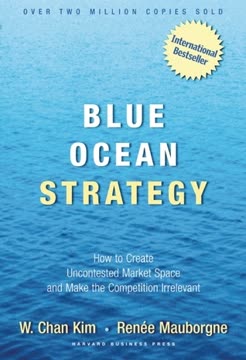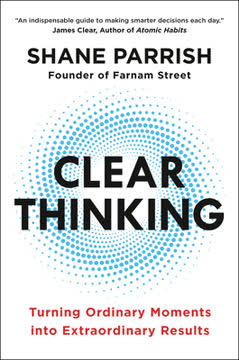Key Takeaways
1. Effective problem-solving requires a structured approach to avoid common pitfalls
"A way of seeing is also a way of not seeing."
Avoid biases and traps. Problem-solving is prone to cognitive biases and pitfalls that can lead to ineffective solutions. Common traps include:
- Flawed problem definition: Misidentifying the core issue
- Solution confirmation: Seeking evidence to support a preconceived solution
- Wrong framework: Applying inappropriate mental models or analytical tools
- Narrow framing: Limiting the scope of potential solutions
- Miscommunication: Failing to convey the solution effectively
To overcome these pitfalls, problem solvers must adopt a disciplined, structured approach that challenges assumptions, considers multiple perspectives, and rigorously tests potential solutions.
2. The 4S Method: State, Structure, Solve, and Sell for comprehensive problem-solving
"To solve big problems and sell solutions like top strategy consultants, you need a disciplined and generalizable problem-solving method and a set of useful tools for each step of the process."
Master the 4S framework. The 4S Method provides a comprehensive approach to problem-solving:
- State: Define the problem accurately
- Structure: Break down the problem into manageable components
- Solve: Analyze and develop solutions
- Sell: Communicate and persuade stakeholders
This method integrates analytical and creative thinking, ensuring a thorough exploration of the problem space and potential solutions. By following these steps, problem solvers can navigate complex challenges systematically and develop effective, actionable solutions.
3. Stating the problem accurately is crucial for finding the right solution
"A problem well posed is half-solved."
Use TOSCA for clarity. Accurately defining the problem is fundamental to finding the right solution. The TOSCA framework helps articulate the problem statement:
- Trouble: What makes this problem real and present?
- Owner: Whose problem is this?
- Success criteria: What will success look like, and when?
- Constraints: What are the limitations on the solution space?
- Actors: Who has a say in how we solve this problem?
By addressing these elements, problem solvers can create a clear, actionable problem statement that guides subsequent analysis and solution development. This step is crucial for avoiding the common pitfall of solving the wrong problem or addressing symptoms rather than root causes.
4. Structuring the problem using hypothesis pyramids or issue trees
"Frameworks are the workhorses of business reasoning."
Choose the right structuring tool. Structuring complex problems is essential for effective analysis and solution development. Two primary approaches are:
-
Hypothesis Pyramids:
- Start with a potential solution and break it down into supporting hypotheses
- Useful when you have a strong candidate solution to test
- Risk of confirmation bias if not carefully managed
-
Issue Trees:
- Break down the problem into component issues without assuming a solution
- More open-ended and less prone to bias
- Requires more effort to develop comprehensively
Both approaches should aim for MECE (Mutually Exclusive, Collectively Exhaustive) breakdowns. Selecting the appropriate structuring tool depends on the problem's nature and your level of certainty about potential solutions.
5. Solving complex problems may require design thinking and empathy
"Empathy is the foundation of design thinking."
Embrace human-centered design. For complex, ill-defined problems, traditional analytical approaches may fall short. Design thinking offers an alternative path:
- Empathize: Understand users' needs and experiences
- Define: Synthesize insights to frame the problem
- Ideate: Generate diverse solution concepts
- Prototype: Create tangible representations of ideas
- Test: Gather feedback and refine solutions
This approach is particularly effective for problems that are:
- Human-centered
- Complex and uncertain
- Difficult to state precisely
- Resistant to traditional analytical methods
By focusing on empathy and iterative solution development, design thinking can uncover innovative solutions that address users' needs more effectively.
6. Generate, prototype, and test innovative solutions through iterative processes
"Fail often to succeed sooner."
Embrace experimentation. Innovative problem-solving often requires generating multiple potential solutions and testing them rapidly. Key principles include:
- Divergent thinking: Generate a wide variety of ideas without judgment
- Rapid prototyping: Create low-fidelity representations of solutions quickly
- Iterative testing: Gather user feedback and refine solutions continuously
Techniques for idea generation:
- Analogical thinking
- Brainstorming and brainwriting
- SCAMPER (Substitute, Combine, Adapt, Modify, Put to other uses, Eliminate, Reverse)
By embracing an iterative, experimental approach, problem solvers can discover and refine solutions that may not have been apparent through purely analytical methods.
7. Sell your solution effectively with a compelling storyline and presentation
"Telling the story of the search isn't the same as telling the story of the solution."
Craft a persuasive narrative. Developing an effective solution is only half the battle; you must also convince stakeholders to adopt it. Key principles for selling your solution include:
-
Use the Pyramid Principle:
- Start with the core message (governing thought)
- Support with key line arguments
- Provide detailed supporting evidence
-
Choose between grouping and argument structures:
- Grouping: Present parallel reasons supporting the core message
- Argument: Build a logical sequence leading to the conclusion
-
Develop a modular presentation:
- Create an executive summary
- Use storyline pages to introduce sections
- Design content pages with clear, action-oriented titles
-
Visualize data effectively:
- Use appropriate chart types for different analyses
- Keep charts simple and focused on the key message
By crafting a clear, compelling storyline and supporting it with well-designed visual aids, you can effectively communicate your solution and drive stakeholder buy-in.
Last updated:
FAQ
What's Cracked It! about?
- Problem-Solving Focus: Cracked It! by Bernard Garrette is centered on teaching readers how to solve complex business problems effectively, similar to top strategy consultants.
- 4S Methodology: It introduces the 4S method, which includes four stages: State, Structure, Solve, and Sell, providing a structured approach to problem-solving.
- Real-World Applications: The book uses real-life case studies to illustrate these concepts, making it practical for business leaders and aspiring consultants.
Why should I read Cracked It!?
- Enhance Problem-Solving Skills: The book offers valuable frameworks and techniques to improve your ability to tackle complex business challenges.
- Learn from Experts: Written by Bernard Garrette, Corey Phelps, and Olivier Sibony, the authors bring extensive academic and consulting experience.
- Avoid Common Pitfalls: It helps readers identify and avoid common pitfalls in problem-solving, such as flawed problem definitions and confirmation bias.
What are the key takeaways of Cracked It!?
- Structured Approach: The 4S method emphasizes the importance of a disciplined process in problem-solving.
- TOSCA Framework: This framework is essential for clearly defining problems before attempting to solve them.
- Importance of Communication: Effectively selling your solution is as crucial as solving the problem itself, integrating communication into the problem-solving process.
What is the 4S method in Cracked It!?
- Four Stages: The 4S method consists of State (define the problem), Structure (organize the problem), Solve (analyze and find solutions), and Sell (communicate the solution).
- Iterative Process: It emphasizes that the process is iterative, allowing for revisiting and refining each stage as new insights are gained.
- Flexibility in Application: The method can be adapted to various contexts, making it versatile for different types of business problems.
How does the TOSCA framework work in Cracked It!?
- Five Elements: TOSCA stands for Trouble, Owner, Success criteria, Constraints, and Actors, guiding problem definition.
- Guides Problem Definition: This framework helps in formulating a clear and actionable problem statement, ensuring all critical aspects are considered.
- Iterative Refinement: Encourages revisiting and refining the problem statement as new information is gathered.
What are the five pitfalls of problem-solving discussed in Cracked It!?
- Flawed Problem Definition: Misdefining the problem can lead to irrelevant solutions.
- Solution Confirmation: Occurs when solvers only seek evidence supporting their initial hypotheses.
- Wrong Framework: Using an inappropriate framework can lead to ineffective solutions.
- Narrow Framing: Oversimplifying complex problems can result in overlooking viable solutions.
- Miscommunication: Poorly communicating solutions can lead to inaction, even if the solution is sound.
What is the difference between hypothesis-driven and issue-driven problem structuring in Cracked It!?
- Hypothesis-Driven: Starts with a candidate solution and tests it, which can lead to confirmation bias if not managed carefully.
- Issue-Driven: Involves breaking down the problem into smaller, MECE components without preconceived solutions.
- Use Cases: Hypothesis-driven is efficient with strong confidence in the hypothesis, while issue-driven is preferred for complex problems.
How can I apply the 4S method in my organization according to Cracked It!?
- Start with State: Begin by clearly defining the problem using the TOSCA framework.
- Structure the Problem: Use a hypothesis pyramid or an issue tree to organize the problem logically.
- Conduct Analyses: Perform analyses to test hypotheses or answer questions in your issue tree.
- Sell the Solution: Communicate findings and recommendations effectively, focusing on audience needs.
How does Cracked It! incorporate design thinking?
- Human-Centered Approach: Emphasizes empathy in problem-solving, aligning with design thinking principles.
- Iterative Process: Design thinking involves phases of empathizing, defining, ideating, prototyping, and testing.
- Real-World Applications: Provides examples of successful design thinking applications, encouraging a creative mindset.
What are some best practices for selling solutions as described in Cracked It!?
- Clear Core Message: Start with a clear core message when presenting solutions.
- Use of the Pyramid Principle: Structure presentations with a logical flow to persuade the audience effectively.
- Engaging the Audience: Use storytelling and interactive discussions to foster a collaborative environment.
What are some analytical frameworks mentioned in Cracked It!?
- Industry Frameworks: Analyze value drivers specific to an industry, such as the Five Forces model.
- Functional Frameworks: Versatile tools applicable across various business contexts, like market segmentation.
- Logical Decompositions: Use logical reasoning to break down problems into manageable components when frameworks are unavailable.
What are the best quotes from Cracked It! and what do they mean?
- “Good analysis is the heart of good problem solving.”: Emphasizes the importance of thorough analysis in developing effective solutions.
- “Prototyping is a highly iterative process.”: Encourages continuous refinement of ideas through prototyping.
- “The ultimate objective of solution selling isn’t to gain intellectual support for your solution, but to trigger action.”: Highlights the importance of clear communication and persuasive storytelling to motivate decision-makers.
Review Summary
Cracked it! receives high praise from readers for its comprehensive approach to problem-solving. Reviewers appreciate the structured 4S method, real-world examples, and practical frameworks. Many find it valuable for both aspiring and experienced consultants, managers, and problem-solvers. The book is commended for its balance of theory and practice, clear writing style, and useful tools like the TOSCA framework and Pyramid Principle. Some readers note its academic tone but still find it highly beneficial for developing problem-solving skills.
Similar Books










Download PDF
Download EPUB
.epub digital book format is ideal for reading ebooks on phones, tablets, and e-readers.




